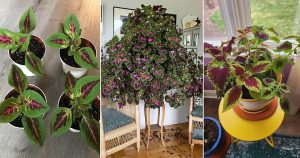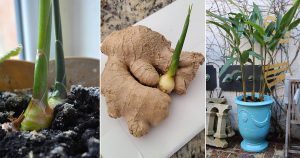Learn How to Grow Christmas Begonia with easy tips in this guide. These lovely flowers will take your holiday decor to the next level!
Growing Christmas Begonia in a home or garden is not difficult if you follow the right directions. Read everything in this post for a thriving plant with pretty blooms.
Botanical Name: Begonia x cheimantha
USDA Zones: 9-11
Christmas Begonia Information

Native to South America, Central America, Asia, and Africa. The Christmas Begonia Begonia (Semperflorens Cultorum Group) features very attractive, large, non-spiral, bright red leaves that are outlined in green with dark red centers and margins. Flowers are pink and appear from fall to early winter. This plant enjoys filtered light but can take some sun in winter. It can reach up to 8 inches to 5 feet tall and 4 inches to 1 foot wide.
It blooms primarily during the winter months, which is why it’s commonly called the Christmas Begonia. The blooming period can extend from late fall into early spring.
This short day begonia is a hybrid species and does not have a natural habitat. It is believed to be a cross between Begonia socotrana and Begonia dregei, combining traits from both parent species.
Types of Christmas Begonias

- Christmas Begonia: Features bright red or pink flowers and attractive foliage, perfect for festive displays.
- Begonia ‘Merry Christmas‘: Known for its large, bright red leaves outlined in green and pink flowers, thriving in filtered light.
- Begonia ‘Ruhrtal‘: A variety with non-spiral, red leaves, pink flowers, and a preference for humidity and filtered light.
- Begonia x hiemalis (Hiemalis Begonia): A compact begonia with waxy leaves and abundant flowers, ideal for indoor or outdoor decor.
- Begonia ‘Frosty’: Showcasing silver-spotted leaves and pink flowers, this begonia adds a touch of elegance to holiday settings.
Propagating Christmas Begonias
Select a healthy leaf with no damage or diseases. Cut the leaf into sections, ensuring each section has a vein. Place the sections on a moist growing medium, like a mixture of peat and perlite. Press the sections lightly into the medium, making sure the cut side is in contact with it. Keep the medium consistently moist and provide indirect light.
After a few weeks, roots should develop, and new plants will begin to grow. Once the new plants have sufficient growth, they can be transplanted into individual pots or the garden.
Choosing a Container for Christmas Begonia
Start with a pot that has a diameter of approximately 8 inches. This size allows enough room for the plant to develop without becoming overly crowded.
When repotting, go for a pot that accommodates your plant’s size with about 1-2 inches of extra space in diameter.
Requirements for Growing Christmas Begonia
Light
Christmas Begonias like bright, indirect light. They’re happy near a window where sunlight isn’t too strong. Avoid direct sunlight, which can harm their leaves. If the light is too dim, the plant may not grow well, so find a spot with enough light to keep your Christmas Begonia healthy.
Soil
For optimal growth, Christmas Begonias prefer well-draining soil rich in organic matter. Use a mix of potting soil, perlite, and peat moss in equal parts. Ensure a slightly acidic to neutral soil pH, ideally between 6.0 to 7.0. This balanced soil blend provides the right nutrients and structure for robust Christmas Begonia development.
Water
Water Christmas Begonias when the top inch of soil feels dry to the touch. Provide a thorough watering, allowing excess water to drain. Avoid soggy conditions, as Begonias dislike overly wet soil. Water at the base to keep foliage dry and prevent potential diseases. Adjust the frequency based on environmental conditions.
Temperature and Humidity
Christmas Begonias thrive in temperatures between 60°F to 75°F during the day and no lower than 50°F at night. Maintain moderate humidity levels around 50-60%. Protect plants from drafts and sudden temperature changes. These conditions create an ideal environment for healthy Christmas Begonia growth.
Christmas Begonia Care
Fertilizer
For Christmas Begonias, use a balanced liquid fertilizer, like 10-10-10, every 4-6 weeks during the growing season (spring to early fall). Dilute the fertilizer to half the recommended strength. Avoid fertilizing during dormancy (late fall to winter). This promotes robust growth and enhances the overall health of your Christmas Begonia.
Pruning
Prune Christmas Begonias to maintain healthy stems. Pinch or cut back leggy growth to encourage new stems. Do this in spring or early summer. Use clean scissors or fingers, as begonia stems are delicate. Regular pruning ensures a bushier plant, improving its appearance and overall vitality.
Pests and Diseases
Mealybugs, spider mites, scales, and thrips are common with begonias. You can treat them by using insecticidal soaps, but be careful not to use too much and test a little bit first to make sure it won’t harm the leaves.
Begonias can be attacked by diseases like stem rot, Botrytis blight, and powdery mildew, especially in damp places without enough air or if the soil is too wet. Bugs can also bother begonias, but these plants don’t like insecticidal soaps much, so it’s better to prevent the bugs.











